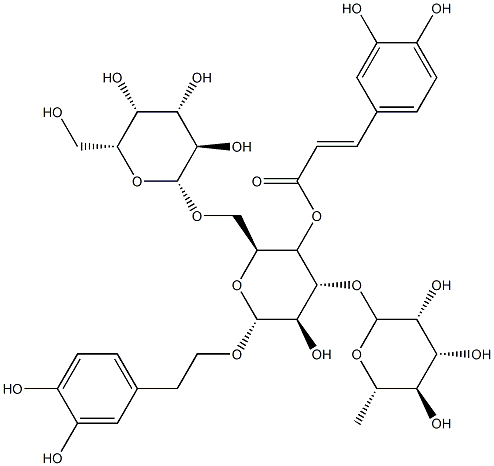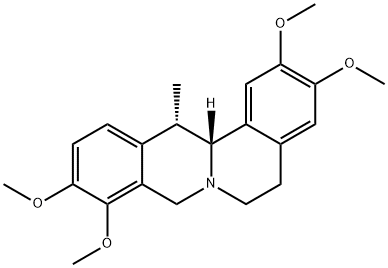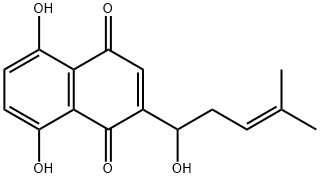VIOLAXANTHIN
Synonym(s):
- CAS NO.:126-29-4
- Empirical Formula: C40H56O4
- Molecular Weight: 600.87
- MDL number: MFCD00075896
- SAFETY DATA SHEET (SDS)
- Update Date: 2024-10-23 13:36:13

What is VIOLAXANTHIN?
The Uses of VIOLAXANTHIN
trans-Violaxanthin, is a Carotenoid dye. It is a natural xanthophyll pigment with an orange color found in a variety of plants including pansies. It is approved to be used as a food additive and food coloring.
The Uses of VIOLAXANTHIN
Violaxanthin has been used as a standard/control in high-pressure liquid chromatography (HPLC) analysis of pigment extracts to confirm the high-level astaxanthin accumulation suspected from the visual phenotype of?Nt-AXT plants.
What are the applications of Application
Violaxanthin (Mixture of Diastereomers) is a carotene epoxide and natural xanthophyll pigment found in a variety of plants, used as a food additive for its orange color.
Definition
ChEBI: All-trans-violaxanthin is the all-trans-stereoisomer of violaxanthin. It has a role as a food colouring.
General Description
Violaxanthins are natural pigmented constituents or carotenoids present in most fruits and vegetables.
Biochem/physiol Actions
Violaxanthin is a carotene epoxide that is a precursor to capsanthin. It is one of three xanthophylls involved in the evolution of plastids of green plants (oxygen evolution) and participating in photo-induced interconversions known as the violaxanthin cycle. The cleavage of 9-cis-epoxycarotenoids (violaxanthin) to xanthoxin is the key regulatory step of abscisic acid biosynthesis.
Purification Methods
Also purify it by column chromatography, and the purity is checked by TLC (see -carotene). It has at 415, 440 and 469nm. [Kuhn & Winterstein Ber 64 326 1931, Karrer et al. max Helv Chim Acta 14 1044 1931, Absolute Config: Bartlett et al. J Chem Soc (C) 2527 1969, Beilstein 19 III/IV 1139.]
Properties of VIOLAXANTHIN
| Melting point: | 200° |
| Boiling point: | 570.8°C (rough estimate) |
| alpha | 20Cd +35° (c = 0.08 in chloroform) |
| Density | 0.9826 (rough estimate) |
| refractive index | 1.4760 (estimate) |
| storage temp. | -70°C |
| solubility | Chloroform, Ethyl Acetate |
| form | Orange Brown Soid |
| pka | 14.56±0.70(Predicted) |
| λmax | λ: 438-442 nm Amax |
| BRN | 101269 |
Safety information for VIOLAXANTHIN
Computed Descriptors for VIOLAXANTHIN
New Products
(S)-3-Aminobutanenitrile hydrochloride 4-Methylphenylacetic acid N-Boc-D-alaninol N-BOC-D/L-ALANINOL Tert-butyl bis(2-chloroethyl)carbamate 3-Morpholino-1-(4-nitrophenyl)-5,6-dihydropyridin- 2(1H)-one Furan-2,5-Dicarboxylic Acid Tropic acid 1-Bromo-3,5-Di-Tert-Butylbenzene S-2-CHLORO PROPIONIC ACID ETHYL ISOCYANOACETATE 2-Bromo-1,3-Bis(Dimethylamino)Trimethinium Hexafluorophosphate 4-IODO BENZOIC ACID 3-NITRO-2-METHYL ANILINE 1-(2,4-DICHLOROPHENYL) ETHANAMINE (2-Hydroxyphenyl)acetonitrile 4-Bromopyrazole 2-(Cyanocyclohexyl)acetic acid 4-methoxy-3,5-dinitropyridine 1-(4-(aminomethyl)benzyl)urea hydrochloride 2-aminopropyl benzoate hydrochloride diethyl 2-(2-((tertbutoxycarbonyl)amino) ethyl)malonate tert-butyl 4- (ureidomethyl)benzylcarbamate Ethyl-2-chloro((4-methoxyphenyl)hydrazono)acetateRelated products of tetrahydrofuran


![5,8-Dihydroxy-2-[(1R)-1-hydroxy-4-methyl-pent-3-enyl]naphthalene-1,4-dione](https://img.chemicalbook.in/CAS/GIF/517-89-5.gif)





You may like
-
 Violaxanthin CAS 126-29-4View Details
Violaxanthin CAS 126-29-4View Details
126-29-4 -
 Violaxanthin CAS 126-29-4View Details
Violaxanthin CAS 126-29-4View Details
126-29-4 -
 1975-50-4 98%View Details
1975-50-4 98%View Details
1975-50-4 -
 2-HYDROXY BENZYL ALCOHOL 98%View Details
2-HYDROXY BENZYL ALCOHOL 98%View Details
90-01-7 -
 2-Chloro-1,3-Bis(Dimethylamino)Trimethinium Hexafluorophosphate 221615-75-4 98%View Details
2-Chloro-1,3-Bis(Dimethylamino)Trimethinium Hexafluorophosphate 221615-75-4 98%View Details
221615-75-4 -
 61397-56-6 CIS BROMO BENZOATE 98%View Details
61397-56-6 CIS BROMO BENZOATE 98%View Details
61397-56-6 -
 14714-50-2 (2-Hydroxyphenyl)acetonitrile 98+View Details
14714-50-2 (2-Hydroxyphenyl)acetonitrile 98+View Details
14714-50-2 -
 118753-70-1 98+View Details
118753-70-1 98+View Details
118753-70-1